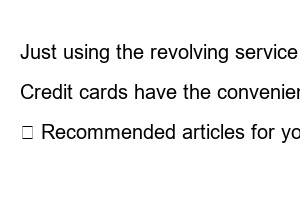리볼빙 신용등급What kind of service is revolving?
A credit card is a card issued to a specific member as proof of delaying the collection of payments for products and services for a certain period of time. To put it simply, the amount paid this month is not deducted from the account immediately, but rather is deducted from the account on the designated payment date of the next month.
Many card companies that handle credit cards provide services with various pros and cons. In this article, we will find out what kind of service credit card revolving is, and how much impact revolving has on your credit rating, along with its disadvantages.
index
Revolving is a payment service in which a card company customer pays only a certain percentage of the card amount used, and the remaining amount is converted into a loan and automatically extended. From the customer’s perspective, the burden of having to repay the card balance all at once is reduced, and the card company has the advantage of having remaining loan assets, which increases asset management effectiveness.
Therefore, revolving is also called ‘rotating payment method’. If you use the revolving service well, you can continue to use your credit card regardless of the payment amount even if the card user lacks payment ability. In addition, since the burden of one-time repayment is reduced, you can prevent delinquency and a decline in your credit score.
In Korea, most people pay their bills on the next month’s payment date. However, in the United States and Europe, 70-80% of credit card users commonly use a service called revolving. From the credit card company’s perspective, it appears that they are actively utilizing this service because the income from revolving fees is better than card fees.
The main disadvantage of revolving is the high commission. From the customer’s perspective, it is good because the burden of lump-sum repayment is reduced, but the fees are higher accordingly. In fact, revolving interest rates range from as low as 5% to as high as 19.99%.
Of course, if you have the ability to immediately repay the fully carried over amount, you can increase the contract ratio to 10%. Conversely, if funds are insufficient, the contract ratio may need to be reduced.
Another downside to revolving is that interest continues to grow. Revolving not only carries over the amount, but also carries over a portion of the card payment that is added each month. In other words, the card balance that card users must repay increases. As the principal increases, the interest on the principal inevitably increases proportionally.
Let’s look at an example to make it easier to understand. Let’s assume that a person who paid 1 million won with a credit card only paid 10%, or 100,000 won. The remaining 900,000 won is carried over to the next month, and in the next month, the carryover amount of 900,000 won and payment interest for the payment amount used in the current month are charged.
In other words, the interest increases as the remaining amount continues to be pushed to the next month. That is why overseas credit card companies earn more from revolving fees.
The amount carried forward through revolving is the unpaid card bill. This means that your card limit will be charged to the amount you haven’t paid. Since the limit is restored to the amount repaid on the payment date, the card limit will continue to be insufficient until it is fully repaid.
Just using the revolving service will not affect your revolving credit rating. However, if the period of using this service becomes longer and the carryover amount continues to accumulate, eventually a decline in your revolving credit rating cannot be prevented. If you use the revolving service for a long time, credit rating agencies may see that you are continuing to use the card even though you do not have the ability to repay the card amount right away.
So far, we have looked into the revolving service and revolving interest.
Credit cards have the convenience of being able to pay immediately, but they also have the function of providing personal credit. Even if the customer does not have the amount needed for payment in their account right now, they can purchase goods and services because they have been provided with credit by the card company. Revolving can be toxic if you don’t know much about it, so be sure to weigh the pros and cons when signing up for the service.
I will come back with a more useful article next time 🙂
▍ Recommended articles for you

